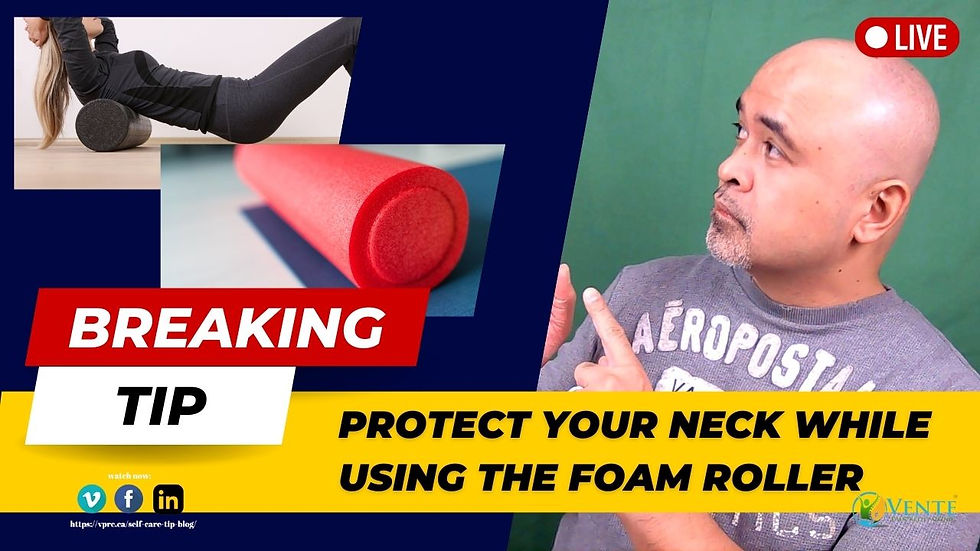Manage Tight Upper Trapezius Muscle; Why Dropping the Shoulders During Exercise is Important
- alfie vente
- Mar 30, 2024
- 3 min read
Updated: Aug 21

Consciously dropping your shoulders “downward” may assist with managing pain and tightness of the Upper Trapezius muscle (The “tops” of your shoulders). This position is considered proper posture. This principle can be applied daily, at your office when you are sitting at your desk and while you are performing certain exercises.
One of the main complaints of patients is pain and tightness of the “tops” of the shoulders. This pain and tightness can be local and/or manifest as referral pain to the side of the head and concentrating in the temples. This is caused by muscles that become so tight that trigger points form and cause this referral pattern.
What Causes the Tightness and Pain?
The main cause of this is when individuals elevate their shoulders for prolonged periods. This shrugging of the shoulders along with a forward head posture can cause the Upper Trapezius to become overworked.
Stress and apical breathing can also potentially cause this muscle to tighten. Apical breathing is basically when you breathe more at the top of your chest. It is generally very shallow breathing and many people who suffer with stress and anxiety tend to breathe in this manner. Apical breathing recruits your secondary muscles of inspiration such as those located in your neck, chest and upper shoulders. This is relative to using more of your diaphragm, which is your primary muscle used for breathing.
Below is the Trigger Point referral pattern for the Upper Trapezius:

Proper positioning of your shoulders, specifically the downward positioning is also very important during exercise especially in exercises such as the Shoulder Press, Lat Pulldown, Chin ups, Standing Arm Curls and Triceps Pressdowns.

Proper positioning of the shoulders also includes drawing your shoulders back by “pinching” the Shoulder Blades together. You want to combine the downward position plus the pinching of the shoulder blades. Specifically for this writing I am just speaking on the downward position.
Why is this important? The Concept of Agonist and Antagonist
The positioning of the shoulders during exercise is very important categorically for those that suffer from chronic pain and tightness of the Upper Trapezius.
There is a constant “tug of war” between the Agonist muscle and the Antagonist muscle. The Agonist is the muscle that is actively shortening to move the joint. The Antagonist is the opposing muscle of that muscle shortening and does the opposite motion of the Agonist.. In order for motion to occur the Antagonist must relax.
As a basic example, we can discuss the action of the Bicep muscle flexing the elbow. The opposing muscle is the Tricep. It extends the elbow as opposed to flexing it like the Bicep. In this example, the Bicep is the Agonist and the Tricep is the Antagonist.
As the Bicep flexes the Tricep has to relax in order for the arm to bend.
Returning to the importance of this concept as it relates to the Upper Trapezius.
The Trapezius is a tripartite muscle. It is broken down into the Upper Fibers (Upper Traps), Middle Fibers (Middle Traps) and the Lower Fibers (Lower Traps).

Each has its own functions as to how it acts on the shoulder (technically the Scapula, the Shoulder Blade). For the purpose of this writing, we will talk about the Upper Traps and the Lower Traps.
One of the main actions of the Upper Traps is to elevate the Shoulder Blade as in a shrugging motion. The action of the Lower Traps is to depress the scapula as in the act of dropping the shoulders.
Therefore there is an Agonist, Antagonist relationship between the Upper Trapezius and Lower Trapezius.
When one actively recruits the Lower Traps to “drop the shoulders” the Upper Trapezius must therefore relax to allow the motion of shoulder depression to occur.
There usually is a strength imbalance with the Lower Trapezius and Upper Trapezius. In essence by making the conscious effort to contract the Lower Trapezius via dropping the shoulders, you are actually strengthening the generally weaker muscle, while you are relaxing an often tight and painful muscle.
Final Thoughts
If you suffer from Upper Trapezius tightness and discomfort this little tip may help. This is of course along with overall posture correction, stretches and Deep Tissue Massage directed to the Upper Trapezius.
Remember this key tip, drop your shoulders downwards in exercises such as the shoulder press, lat pulldown, dips, chinups, standing bicep curls and tricep pressdowns.
It may help ease the pain and discomfort from Upper Trapezius tightness.









Comments